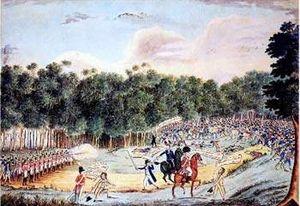
Charles Allen Du Val
His life and works
Thomas Ainsworth Anlezark
| Thomas Ainsworth Anlezark |
|---|
| Born: 1772 Pleasington, Lancashire |
| Died: 1834 Sydney, Australia |
| Father |
| James Anlezark 1729-1772 |
| Mother |
| Margaret Ainsworth 1733-1771 |
| Siblings |
| John Anlezark born 1753 |
| Jeanetta Anlezark 1756-1841 |
| James Anlezark born 1758 |
| Sarah Anlezark born 1760 |
| The Reverend Robert Anlezark 1764-1845 |
| Ann Anlezark born 1769 |
| Spouse |
| Ann Starmer 1767-1825 married 1804 |
| Children |
| James Anlezark 1806-1874 |
| Sophia Anlezark 1807-1876 |
| John Anlezark 1812-1889 |
| Thomas Anlezark 1812-1815 |
Thomas Ainsworth Anlezark was born in 1772 at Pleasington Hall in Lancashire, the son of James Anlezark 1729-1772 and his wife nee Margaret Ainsworth 1733-1771.
In 1789, age 18, he enlisted in the 3rd Dragoon Guards. He was discharged in August 1797. In 1800 he was indicted at Bury St Edmunds Assizes that "In company with five others, he did at midnight on 22nd September 1800, steal two silver cases valued at twenty shillings, a silver cream pot at six shillings, a pair of silver tongs at two shillings, seven silver teaspoons at six pence, and four pounds in money". Thomas Ainsworth Anlezark was found guilty, and sentenced to death by hanging. However his sentence was reduced to life imprisonment (1).
After being confined for two years on the prison hulk Coromandel at Portsmouth, he was put aboard the convict ship Perseus at Spithead on 12 February 1802 for transportation for the rest of his life to Australia. He arrived at Port Jackson (Sydney) on 14 August 1802 (2).
There he must have been an exemplary prisoner because he received a Conditional Pardon on 16th June 1803. He was appointed a Mounted Trooper, and served in putting down the "Castle Hill" rebellion of Irish convicts at Toongabbie in March 1804. This rebellion was also named "The Battle of Vinegar Hill", as some of the Irishmen had been sentenced to transportation to Australia for life following their defeat at Vinegar Hill in County Wexford in the 1798 uprising in Ireland (3).

A painting was made by an eye-witness of the engagement which took place at Toongabbie on 5 March 1804.
On the far right a rebel is saying "Death or Liberty Major". Major George Johnston (the Commnder) replies "You scoundrel. I'll liberate you!". Next to the left is shown Trooper Anlezark dispatching another rebel leader. Trooper Anlezark acquitted himself so well that he received an Absolute Pardon in June 1804.
In 1804 he married Ann Starmer 1767-1825 born in Kettering, Northamptonshire. She was also a convict, and had been sentenced to transportation for seven years.
They had the following children:
James Anlezark. He was born on 3 February 1806 in Liverpool in Sydney, Australia. He was twice married, first to Elizabeth Jane Smith (by whom he had a son and four daughters) and secondly to Matilda Hawthorne (by whom he had a son and a daughter). He died in Parramatta on 24 December 1874.
Sophia Anlezark. She was born in 1807 in Liverpool in Sydney. She was twice married, first to William Edwards (by whom she had two sons and five daughters) and secondly to Thomas Shaw. She died at Towrang in New South Wales on 11 October 1876.
John Anlezark. He was born on 17 March 1812 in Liverpool in Sydney. He married twice, first Mary Ann Doyle (by whom he had three sons and five daughters), and secondly Catherine Morrissy (by whom he had six sons and three daughters). He died at Argyle in New South Wales on 10 March 1889 aged 76 years.
Thomas Anlezark. He was born on 17 August 1812 and died on 13 August 1815 aged two years.
Their father Thomas Ainsworth Anlezark died at Liverpool, a suburb of Sydney in New South Wales, Australia on 3 April 1834, and was buried in Liverpool Pioneers Memorial Park.
(1) Prison Hulk Registers and Letter Books 1802-1849. His entry is misspelled "Thomas Andelzack". Of the six men sentenced at Bury St Edmunds Assizes on 19 March 1801, two were convicted of robbery and sentenced to confinement on board a prison ship for life: Thomas Ainsworth Anlezark was imprisoned on the hulk Coromandel and Edward Cureton on the Glutton. The other four were convicted of what was evidently the lesser crime of grand larceny and sentenced to imprisonment for seven years on moored hulks. Thomas Brown served his sentence on the hulk Laurel. William Bannister and William Lockwood served out their time similarly confined, and George Smith died on 27 January 1802 before completing his similar sentence. (Winters must have been particularly terrible on those ancient and disease-ridden wooden ships.)
(2) His entry in the New South Wales, Australia, Settler and Convict Lists 1787-1834 gives the date as June 1802, but the August date seems more likely. His surname in the Convict Lists is mispelled as "Andlezark".
(3) On 21 June 1798 a decisive engagement was fought against the Irish uprising when British soldiers launched an attack on Vinegar Hill outside Enniscorthy in County Wexford, the main encampment of the Wexford United Irishmen. Fighting actually took place both on Vinegar Hill itself and in the streets of Enniscorthy.
